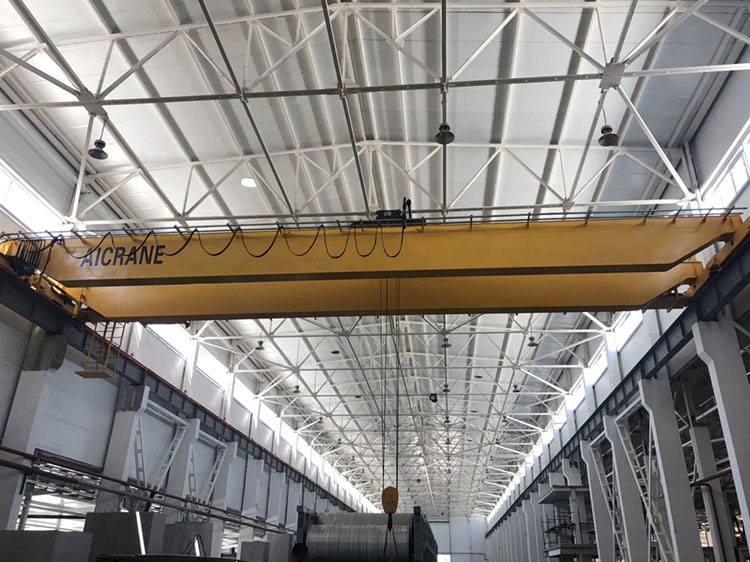When selecting, operating, or maintaining an overhead crane, one of the most critical terms you will encounter is “capacity.” While the word might seem straightforward – how much weight the crane can lift – the actual meaning in an industrial and engineering context is much deeper. Misunderstanding crane capacity can lead to unsafe operations, equipment damage, and costly downtime.
This article will explain in detail what overhead crane capacity means, how it is determined, the factors that influence it, and why understanding it is vital for safe and efficient lifting operations.

1. Defining Overhead Crane Capacity
In the simplest terms, overhead crane capacity refers to the maximum rated load that the overhead crane can safely lift and move under specified conditions, as designed by the manufacturer. This is not a rough estimate – it’s an engineering limit based on structural strength, mechanical components, and safety factors.
-
Rated Capacity (Working Load Limit – WLL): The maximum load the crane is designed to handle under normal working conditions.
-
Proof Load: A higher load (usually 125% of the rated capacity) used during load testing to verify the crane’s structural and mechanical integrity.
-
Design Load: The calculated load used in the crane’s design, which includes both the weight of the lifted load and the weight of any attachments, spreader beams, or hooks.
It’s essential to note that capacity refers to the entire system – including the bridge, runway beams, end trucks, hoist, trolley, and all supporting structures – not just the hoist itself.
2. How Crane Capacity is Determined
Manufacturers determine overhead crane capacity using a combination of engineering calculations, material properties, and safety standards. Several key considerations influence the final capacity rating:
a. Structural Strength
The crane’s main girders, end trucks, and runway beams must be strong enough to support the load without bending, cracking, or failing. Engineers calculate these factors based on steel strength, span length, and expected loading cycles.
b. Hoist and Trolley Ratings
The hoist – the component that actually lifts the load – must have a motor, gearbox, and rope or chain system strong enough to lift the rated weight without failure. The trolley must also be designed to support both the hoist and the load.
c. Runway System
Even if the crane’s bridge and hoist can handle the load, the runway beams and building structure must also support the forces generated during lifting and traveling.
d. Safety Factors
Engineering standards such as OSHA, FEM, and CMAA require safety margins to ensure the crane can handle unexpected stresses, such as sudden load shifts or environmental factors.

3. Factors That Can Reduce Effective Capacity
While the rated capacity is fixed in the manufacturer’s specifications, real-world operating conditions can reduce the safe working limit. These factors include:
-
Load Position: Lifting a load far from the crane’s centerline or lifting at an angle can create side loads, reducing safe capacity.
-
Environmental Conditions: Extreme temperatures, high winds, or corrosive environments can weaken materials and components.
-
Load Dynamics: Sudden starts, stops, or swinging loads increase the forces on eot crane components, effectively lowering safe capacity.
-
Wear and Tear: Over time, fatigue and component wear can reduce the crane’s ability to safely handle its original rated load.
-
Attachments and Below-the-Hook Devices: The weight of spreader beams, magnets, grabs, or hooks counts toward the total load, reducing the available capacity for the lifted object.
4. Misconceptions About Crane Capacity
There are several dangerous misunderstandings about crane capacity that operators and maintenance teams must avoid:
-
“It Can Lift More if Needed” – A crane is not like a vehicle where you can push it a bit harder; exceeding rated capacity risks catastrophic failure.
-
“The Hoist Capacity = Crane Capacity” – Even if the hoist is rated higher, the rest of the crane’s structure might not support that load.
-
“Capacity is the Same in All Directions” – Certain travel positions or load placements may reduce safe capacity.
-
“Capacity Never Changes” – Wear, damage, or modifications can reduce safe working capacity.
5. Why Understanding Capacity is Critical
Knowing and respecting the rated capacity of an industrial overhead crane is essential for several reasons:
-
Safety: Overloading is one of the most common causes of crane accidents, leading to injuries, fatalities, and severe property damage.
-
Equipment Longevity: Consistently operating near or above rated capacity accelerates wear and reduces service life.
-
Regulatory Compliance: OSHA and other authorities require operators to follow manufacturer specifications for load limits.
-
Operational Efficiency: Selecting the correct crane capacity ensures smooth handling without bottlenecks or damage.
6. Capacity Plates and Load Charts
Every overhead crane should have a capacity plate or marking that is clearly visible to operators. This plate typically shows:
-
Rated load in kilograms or tons
-
Manufacturer name and model number
-
Serial number
-
Duty classification (CMAA Class C, D, etc.)
-
Special instructions or limitations
Some cranes also have load charts, especially in cases where capacity changes depending on the load’s position along the span.
7. The Role of Load Testing
Before being put into service, new cranes must undergo a load test, typically at 125% of rated capacity, to ensure the structure and components perform as expected. Periodic load testing during the crane’s service life helps verify that the original capacity rating is still valid.
8. Practical Tips for Managing Crane Capacity in Operations
-
Know Your Load: Always determine the exact weight of the load and any attachments before lifting.
-
Stay Within Limits: Never attempt a lift above rated capacity, even for a short distance.
-
Train Operators: Ensure all crane operators are trained to understand capacity ratings and their implications.
-
Inspect Regularly: Perform scheduled maintenance and inspections to ensure the crane can still handle its rated capacity.
-
Monitor Loads: Use load monitoring systems to provide real-time weight readings and prevent overloads.
9. Final Thoughts
Overhead crane capacity is far more than just a number – it’s the result of detailed engineering, safety standards, and careful consideration of every component in the lifting system. Understanding what capacity means, how it’s determined, and how to work within its limits is essential for safe and efficient material handling.
Treat capacity limits not as suggestions, but as absolute safety boundaries. Doing so not only prevents accidents but also maximizes the service life of your crane, protects your investment, and keeps your operations running smoothly.
